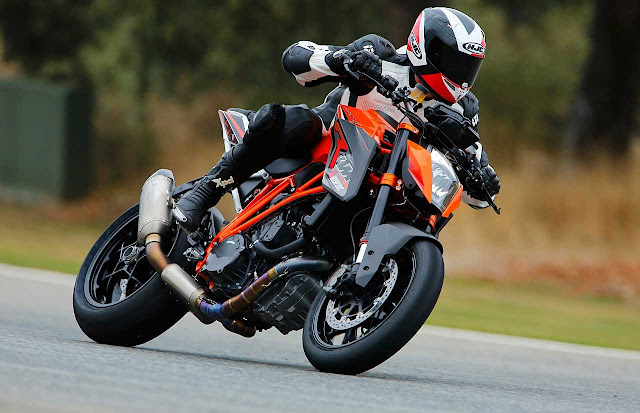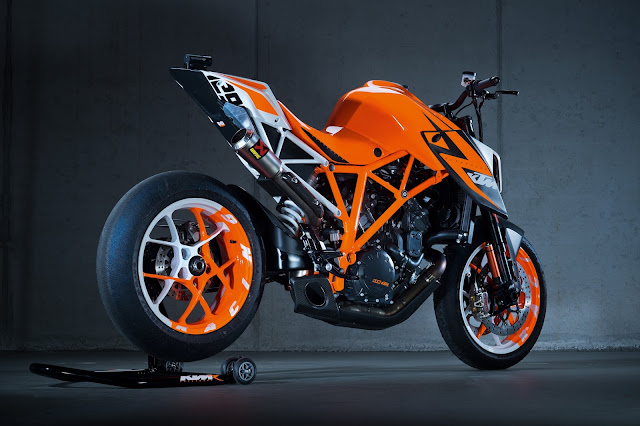KTM Super Duke
Pure speed was not the Super Duke’s forte, hut its punchy V-twin engine generated thrilling straight-line perform
Angular styling and fairly upright riding position gave little hint of the KTM’s outrageously unrestrained character.
KTM had already shown its ability by producing many excellent single-cylinder models plus the highly regarded Adventurer 950 dual-purpose bike when the Austrian firm released its first large-capacity roadster. But even so, the Super Duke created a stir. With its angular styling, punchy 999cc V-twin engine and ultra-responsive chassis, the Super Duke was a strikingly aggressive machine, even when compared to rivals such as Ducati’s Monster S4R and Aprilia’s Tuono.
The Super Duke’s arrival was an important landmark in the short history of KTM. Since the firm’s rebirth in 1992 it had increased annual production to over 75.000. while recording an impressive list of off-road World Championship wins, dominating the Dakar Rally, and even earning road-race Grand Prix success in the I25cc class.
But KTM’s ambition was to become Europe's leading bike manufacturer; hence the attack on the large-capacity roadster market.
The Super Duke's format of dohe, 75-degree V-twin powerplant and tubular steel frame followed that of the Adventurer but there were many differences between the two. beyond the obvious ones of the new machine's sharp streetbike styling, short-travel suspension and smooth Pirelli rubber. Engine capacity was increased from 942 to 999cc. New internals included lighter forged pistons, conrods and one-piece crankshaft. The six-speed gearbox was also new, as was the fuel-injection system that helped increase peak power output to 120bhp at 9000rpm.
Tuneful and responsive
Despite its upright, off-road influenced riding position, the Super Duke felt sporty and aggressive, helped by a tuneful exhaust note from twin high-level silencers. Its peak power output was impressive but it was the V-twin unit’s instant throttle response and broad spread of torque that made the biggest impression. Given a tweak of the throttle at almost any revs in the lower gears, the V-twin leapt forward in exhilarating fashion, often with its front wheel in the air. And it kept accelerating hard, too, staying reasonably smooth as it charged towards a top speed in excess of 160mph (257km/h).
Handling was superbly sharp, thanks to a combination of light weight, rigid chrome- molybdenum steel frame, racy geometry and high- quality suspension from KTM-owned Dutch specialist WP. Big twin Brembo front brake discs with four-piston calipers gave fierce and fade-free braking. Generous tyre grip and near-limitless ground clearance also helped make the KTM hugely enjoyable on a twisty road. If there was a drawback it was that the ultra-sharp response to both throttle and steering made this naked supersports machine demanding to ride.
That rather manic feel combined with the windblown riding position and poor fuel range to ensure that the Super Duke was far from the world’s most practical or relaxing bike - but on the right road it was certainly one of the most exhilarating.
It was seriously addictive; a real hooligan’s tool whose unique blend of torquey motor, lightness and agility added a new dimension to the ranks of naked V-twins. KTM was determined to become as important a player on the street as it already was in the dirt. The bold and brilliant Super Duke was a mighty good way to start.
Sibling Rival: the Supermoto 950
A year after the Super Duke's launch, KTM broadened its big-bike range with the 950 Supermoto. A blend of the firm's first two big-bore models, the Supermoto matched the Adventurer's 942cc, 98bhp V-twin engine and long-travel suspension with the Super Duke's 17- inch wheels, sticky roadgoing rubber and more powerful front brake. The Supermoto couldn't quite match the speed and racer-like handling of the Super Duke, but its additional versatility and comfort made it popular.
Sharing the Adventurer's carburetted engine also meant that, unlike the Super Duke, it was homologated for sale in the US - a market that became more important when KTM became financially linked with US based ATV and bike-producing giant Polaris.
Specification KTM Super Duke (2003)
- Engine Liquid-cooled dohc eight-valve 75-degree V-twin
- Capacity 999cc (101 x 62.4mm)
- Maximum power 120bhp @ 9000rpm
- Tramsmission Six-speed, chain final drive
- Frame Tubular steel ladder
- Suspension Telescopic front, monoshock rear
- Brakes Twin discs front, disc rear
- Weight 394lb (179kg)
- Top speed 165mph (265km/h)




















0 comments: